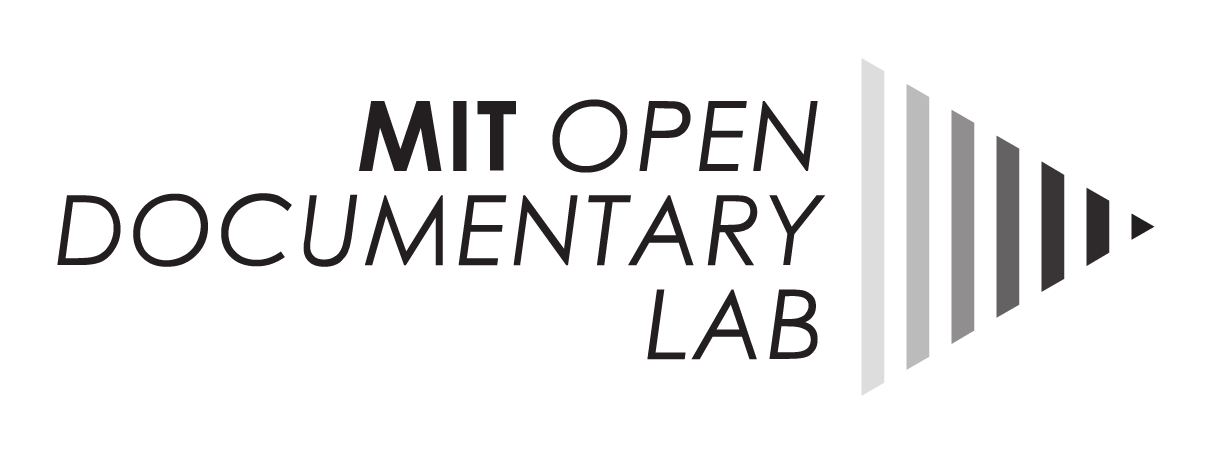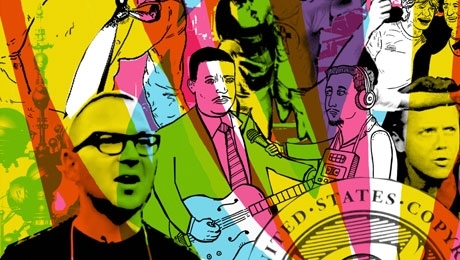
11 Apr The New Digital Storytelling Series: Brett Gaylor
The MIT Open Documentary Lab teamed up with Filmmaker Magazine on The New Digital Storytelling Series, a group of interviews with leading digital storytellers, technologists and curators. This interview was previously published on FilmmakerMagazine.com and is reposted with permission.
In the sixth part of Filmmaker‘s interview project with prominent figures from the world of transmedia, conducted through the MIT Open Documentary Lab, Brett Gaylor, Senior Director of Mozilla’s Webmaker initiative (including Mozilla PopcornMaker and Popcorn.js) answers our questions. Gaylor has previously been a member of the EyeSteelFilm documentary production company, the founder of Open Source Cinema and the web producer of Homeless Nation.
For an introduction to this entire series, and links to all the installments so far, check out “Should Filmmakers Learn to Code,” by MIT Open Documentary Lab’s Sarah Wolozin.
MIT Open Documentary Lab: How did you become a digital storyteller? Were there any projects that inspired you? If not, where did you look for inspiration?
Gaylor: My parents bought me a Mac Plus when I was about 12 years old. Our school district had a really progressive program where they would subsidize the purchase of a computer, and I had been asking for one for years. I had actually wanted a commodore 64 when they were in vogue, obviously for all the video games, but we couldn’t afford one. The Mac Plus shipped with a really amazing piece of software called HyperCard. Iit was a hypertext platform that pre-dated the web, so it allowed you to create “stacks” of “cards” that you could link together with a really simple authoring language called HyperTalk. The great thing about HyperCard was that it allowed you to program these interactions with a simple point and click interface, but you could also see the code that these interactions generated, so the logic was made immediately apparent. The language was very easy to understand – you had instructions like:
On MouseUp
Go to Next Card
End MouseUp
I started wondering what could happen if I put other instructions inside those events, or the same instructions with different events, and it really encouraged a non-linear way of understanding a system. So I could do:
OnMouseUp
Play “boing”
End Mouseup
– and Hypercard would play a sound. So from there, I had enough building blocks that with a friend I would spend weekends making dorky comic book adventures or simple games. When the web became accessible, I was just leaving high school, and it was a very natural extension. But it was immediately obvious to me that adding the network to a hypertext system was the real game changer – the difference between being able to link between a set of cards on my own computer, and any resource on any computer connected to the network, was really exhilarating. The great thing about the web is that “view source” was built into all the early browsers, so I just checked out how my favourite web sites were built, and remixed and changed enough of them so that I could learn the basics of HTML and then create my own pages.
Taking this excitement into University, I immediately wanted to apply these ideas to documentary – I built websites for Canadian filmmakers like Velcrow Ripper and Daniel Cross, and eventually collaborated with Daniel on a project called “Homeless Nation,” which was before the days of popular social networks like myspace or facebook. Daniel had been making a series of films around homelessness, and in each film wanted the subjects of the film to have increased autonomy in how their stories were told. He was frustrated in how the editing process of a feature documentary left so many voices on the editing room floor, and so we and others collaborated on a platform, outreach network and non profit organization that promoted digital literacy among the homeless and those living in poverty. We spent several years doing outreach in Montreal, Toronto and Vancouver, and built a platform at homelessnation.org that featured video blogging, podcast and blogging that was the first website built by and for the street community in Canada, and I believe the world.
I’ve always been interested in issues of voice and representation in media, which was also the inspiration behind Open Source Cinema (which is no longer alive) – in the same way Homeless Nation allowed people who were normally subjects to build the media work, I wanted to shift this power to the audience as well. I think that’s the ultimate promise of the web, that the audience can also be the publisher, that still excites me. I’m really only interested in interactivity on the web – I respect what people create on gaming platforms in other interactive media, but I caught the web bug early and care deeply about how it evolves. With Mozilla, I’ve worked on creating tools to help move consumers of the web to creators of the web, working on Webmaker.org and Popcorn Maker.
MIT Open Documentary Lab: What are the most useful skills for an interactive storyteller? What are the tools of the trade?
Gaylor: I think in the same way a documentary film director is a sort of selector, almost a DJ, the interactive storyteller is similar in that they’re choosing the best visual elements, the best modes of interaction, the art direction, the sound design, and ensuring these items are welded together into a cohesive experience. There was a panel at SilverDocs last year called “Documentary Filmmaker as General Contractor.” I didn’t get to go to the panel but I really loved that title! I think it applies to interactive storytelling as well.
So something like “Passionate generalist with excellent mash-up skills” would probably be on the resume.
MIT Open Documentary Lab: When you start an interactive project, how do you put together a team?
Gaylor: I can’t remember who said it, but they say each interactive project needs a “Designer, Developer and a Dictator”. I’m not sure how I feel about the last one, but it does capture the essence of what you need. Obviously someone who can write the code, someone who can be the bottom line on user experience, and someone who can project manage and make the final decisions. Making any sort of software project is basically about making hundreds of decisions a day, and if that is the role you are playing in the project, you need to have the same skill as a film director – knowing when to make firm decisions and have a vision, and when to listen to your collaborators and let them do their job.
Each project and each team will have its own configuration – some people perform all three roles, some people land on different parts of the spectrum when it comes to decision making, etc. Some films are made with a bolex, others need a crew and a lunch truck. Some directors edit their own work, others like to shoot.
MIT Open Documentary Lab: Where is this community and how can people access it?
Gaylor: It depends on which type of interactive work you’re talking about. For web documentary, I’d have to say that the strongest and most sustained communities are in academia – so groups like iDocs have been convening practitioners and academics together for many years. These groups are great because they are able to see the meta-trends – the things that connect traditions of documentary and interactive/new media, for example. MIT’s Open Doc Lab is another more recent example.
The folks at the International Documentary Festival of Amsterdam (IDFA) have been programming interactive work for a few years now – its probably the most important documentary festival in the world, and I’d say the same applies to it’s interactive strand, DocLab. This is where many projects are financed, curated and exhibited.
If you’re talking about pure software rather than interactive film, there are many communities. I work for the Mozilla Foundation, which has a very vibrant community that supports our work – the Firefox Web browser, the new FirefoxOS (for mobile phones) and the Webmaker project which I’m a part of all have contributions from people outside of our staff. Often times these communities are misunderstood – people might assume that our contributors are basically really enthusiastic versions of our customers – ie they love Firefox a lot and also happen to know how to write code, so they pitch in. That isn’t how it works. Our contributors (and indeed any open source contributor) usually have some sort of self-interest. So they might need something that Popcorn.js doesn’t currently do, and they’ll submit the necessary code to make that work. A recent example of this is that developers at the Internet Archive wrote the support so that videos hosted there could be used with the software. We review these contributions at Mozilla and then merge the code in. In this way, we can have a broader reach than our small team could provide otherwise, and more important we can support “innovation at the edges” and support use cases that we might not even know about.
We’ve created a really robust community around Popcorn.js, our media sequencing framework. You can find information about that at popcornjs.org. The more journalism-oriented should definitely check out Source, which is part of OpenNews, Mozilla’s partnership with the Knight Foundation.
A lot of communities spring up around software projects and come together for hackathons, meetups, etc. I think the documentary world can borrow a lot from this. In software, the way it often works is that an application will open its API (Application Programming Interface), to see what developers will build with this data. In the same way, documentary filmmakers can open up their research, their access, their footage, or whatever aspects of their work that make sense and the creators are comfortable sharing. By doing this, they can attract collaborators and contributors to their project that have value of their own to share.
MIT Open Documentary Lab: How does the role of a director change? What are the creative challenges?
Gaylor: I wrote about this on my blog. It’s pretty similar, really. You need to assemble a team of great collaborators, let them practice their craft, while at the same time identifying a vision. You have to try and make the right calls about when to be flexible and when to be firm.
MIT Open Documentary Lab: How does the role of the audience change?
Gaylor: Some people don’t like the word “user” – they feel it is too generic or debases the intellectual or aesthetic experience that someone might have on the web. I disagree, or maybe I just don’t think we have a better word. The difference between someone who watches a film and someone interacting with a web page is that one is consuming and the other is using. I don’t feel that one experience is superior to another, but they are different.
A friend of mine, Jeronimo, who is a filmmaker and interaction designer, said something that I’ve always used to interrogate my work and the work of others. Whenever you describe an interactive experience with “A User Can….”, replace this with “A User Must….” and then see if the experience holds up – if you would do this yourself. So, if “a user can enter their zip code to receive customized films for their location” becomes “a user must enter their zip code to watch a film”, then you are forced to confront whether the interaction you’re developing is user friendly.
MIT Open Documentary Lab: What’s your level of understanding of coding or programming? Do you see the relationship of director and creative technologist as analogous to director and cinematographer? (Why or why not?)
Gaylor: I don’t write JavaScript, but I can write “restaurant HTML” as Roger Ebert liked to say. It isn’t essential but obviously it helps you work with your collaborators if you speak in as much detail as possible. The most important thing is to understand your work as a system, as a computer program that has inputs and outputs, that has an information architecture that needs to be planned. You don’t need to program to be able to create this.
I suppose it is similar to the relationship between a cinematographer and a director, in that the director needs to understand how different focal lengths, depth of field or lighting choices can be storytelling tools. The cinematographer will apply their craft to making these concepts real and excellent, and you could say that this is what a developer does as well. Really, though, it’s just a similar relationship to any collaborative art – whether you’re producing an album, putting on a play, making a movie or a web documentary, different talents contribute different components.
What you want to avoid is a service relationship. I’ve rarely seen filmmakers happy with the results of handing of a spec to an agency. The best developers also see themselves as creators, as makers. Each project is it’s own venture, its own show that will come together for a fixed period of time and then dissolve. Pick your collaborators well and treat them as equals.
MIT Open Documentary Lab: How do you find funding for digital interactive storytelling projects?
Gaylor: For web documentary, Arte in France/Germany and the National Film Board of Canada are heavy investors and innovators. ITVS supports US as well as international producers. Foundations like Ford and MacArthur support documentary work, and increasingly, interactive documentary. Tribeca now has a strong annual commitment to nonfiction interactive work, and are holding regular hackathons and events to bring the digital and filmmaking world’s together. Like most other artistic endeavours, crowd funding is a serious piece of the puzzle.
MIT Open Documentary Lab: What’s your idea of the new model of distribution?
Gaylor: Well, the web is pretty amazing for distribution! Nothing beats it for getting your work in front of people. I think your question might be “what is the model for paying artists who choose to distribute their work on the web,” and that’s perhaps more thorny. To be honest, when I worked in documentary film, we always paid ourselves while we were making the work. We raised a budget that could allow us to make good, living wages based on our labour. This pretty much always involved pre-selling the work to broadcast television. We didn’t assume that we’d get paid every time the work played on television – they purchased a license. The business models of the networks were advertising, direct patronage (PBS and public media) or government subsidy. While these models still exist, it’s getting tougher in Canada (of which I’m best suited to comment) to raise a budget for one-off, point of view documentary. These challenges also exist for the type of auteur driven, web documentary that we’re discussing. So yes, it is difficult, but it has always been difficult to raise budgets for documentary production and always will be.
One thing that is obvious but bears repeating, is that the business model for web-based creativity is evolving. What makes sense now won’t make sense tomorrow, because what makes sense tomorrow probably hasn’t been invented yet.
MIT Open Documentary Lab: What’s your vision for how to exhibit interactive projects?
Gaylor: I understand that people like installations, but I personally feel that interactive work needs to succeed on a user’s computer. It needs to be compelling enough for them to close their tabs, turn off the email, and watch, listen and interact. I know that at DocLab they have directors navigate their work in front of an audience, which I like, because it’s in some way a performance of one user’s journey. But ultimately, it has to work as personal experience for each user.




